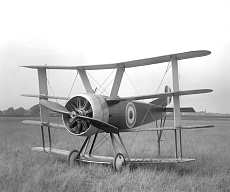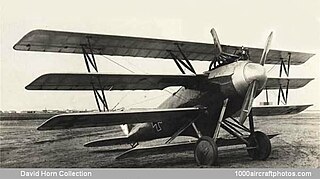The Schütte-Lanz D.III was a German fighter prototype during World War I. It participated in the first Idflieg D competition at Adlershof, Germany in January and February 1918. It was a conventional single-bay staggered biplane with N-type interplane struts. Of wooden construction with fabric skinning, the D.III revealed an unspectacular performance and production was never continued.

The Fokker D.IX was a Dutch single seat, single engine fighter aircraft, the final, more powerful evolution of the Fokker D.VII World War I success, flown in 1921. The sole example was purchased by the US Army Air Service but not developed further.

The Siemens-Schuckert DDr.I was a World War I German twin engine, push-pull configuration triplane fighter aircraft. Only one was built, crashing on its first flight.
The Kondor E 3, sometimes erroneously known as E.III, was a German single seat, monoplane fighter aircraft designed and built close to the end of World War I. Though successful in the third D-type fighter competition at Aldershof in September 1918, only a few were produced, given the Idflieg designation of Kondor D.I.
The Kondor D 7 was a prototype German single seat biplane fighter built over the winter of 1917-18. It was not a success and its development was soon abandoned.

The Kondor D 6 was a prototype German biplane fighter aircraft flown in 1918. In the interests of better upward vision for the pilot, its upper wing was in two halves, separated over the central fuselage. Its development was soon abandoned.

The Pfalz D.XV was a German single seat fighter aircraft which was approved for production right at the end of World War I, too late to enter service.
The Pfalz D.VII was a German biplane fighter aircraft from World War I. It was not put into production.
The Pfalz D.VI was a German sesquiplane fighter aircraft from World War I. It was not put into production.
The Weymann W-1 was a French single seat biplane fighter aircraft, built during World War I. It had a most unusual layout, with an engine buried in the fuselage driving a pusher configuration propeller behind a cruciform tail. It was not successful and soon abandoned.

The Hanriot HD.15 was a French two seat fighter aircraft fitted with a supercharger for good high altitude performance, built in the 1920s. Three were ordered by Japan but lost at sea during delivery.

The Hanriot H.26 was a French single seat fighter aircraft prototype completed in 1923. Only one was built.

The LFG Roland D.IX was a World War I German single seat fighter aircraft, a biplane powered by one of a new generation of powerful rotary engines. Three slightly different prototypes were built but there was no series production.

The LFG Roland D.XV was a World War I German single seat fighter aircraft, ordered as a test-bed for engine comparisons. It was distinguished from earlier Roland biplane designs by the elimination of flying wires. Two later aircraft, also called LFG Roland D.XV, were completely different designs with slab sided fuselages.
The Schütte-Lanz D.VII was a single engine, biplane fighter aircraft designed and built in Germany towards the end of World War I.
The Albatros C.VIII N was a German large, single engine biplane bomber, intended for night time operations, It was seriously underpowered and could only carry a small bomb load.

The Albatros C.XIV was a German two seat, single engine, biplane fighter aircraft built in 1918. Only one was constructed.

The Albatros L.71 was a two-seat, single pusher engined biplane built in Germany in the 1920s.

The Wight Quadruplane, also referred to as the Wight Type 4, was a British single seat quadruplane fighter aircraft built by J Samuel White & Company Limited during World War I. Testing revealed design deficiencies and after the only example was involved in a crash, further work on the aircraft was abandoned.

The Naglo D.I was a German single seat quadruplane fighter, flown late in World War I. It took part in one of the fighter competitions but did not reach production.












